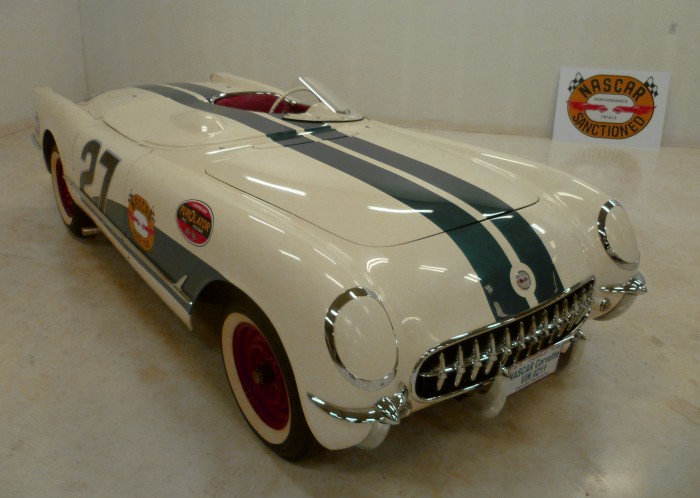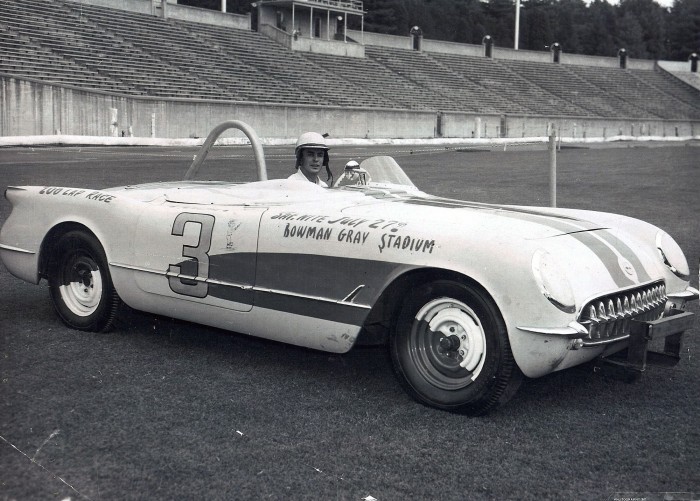
Photos courtesy Terry Michaelis.
by Jim Donnelly as republished from Hemmings Daily Blog
A lot of car people, and especially a lot of people who like Chevrolet, know the basic framework of the story. The Corvette started out as a show car during the Motorama shows presented by General Motors and made it to production on the cheap. Snail-like sales of the hallowed originals – just 300 in 1953 – nearly led to the car being dropped. Folklore has Zora Arkus-Duntov delivering an over-my-dead-body ultimatum that kept the Corvette alive. The real story is more complicated and compelling. It involves a very special early Corvette that predicted its future remaking as a true sports car with V-8 power. The car is also being extensively shown at some of the country’s most prestigious car shows.
It’s in the collection of Pro Team Corvette, the dealer and restorer of classic Corvettes based in Napoleon, Ohio. We’ve been in touch with Pro Team president Terry Michaelis, who has not only been generous with information on Corvette number 211, but is also asking the Hemmings Nation for help on researching its racing history. But first, let’s look at the car.
It’s a 1953 Corvette with VIN number E53F001211, making it the 211th example produced that year. Through research, the Pro Team crew has identified it as a car that was handed over to Chevrolet Engineering, where it was rebuilt under the direction of 1940s Indianapolis 500 winner Mauri Rose. The car was outfitted with a 265-cu.in. small-block V-8 equipped with dual Carter four-barrel carburetors, powering a three-speed manual transmission and the rear end from a V-8 Chevrolet sedan of 1955 or 1956. Remember that all production 1953 Corvettes used the Blue Flame overhead-valve straight-six and a Powerglide automatic.

The exact sequence of what happened next is a little murky, which is why Terry is looking for help from us. At some point, 211 was refitted with a 1955 body and turned over to NASCAR. There is photographic evidence of NASCAR founder Big Bill France running on the sand during the Daytona Beach speed trials. During those years, NASCAR had a number of ventures beyond its famous Strictly Stock or Grand National stock car division. One of them was a short-lived circuit called SCODA, which stood for Sports Car Owners and Drivers Association (around the same time, NASCAR also had a Speedway Division for Indy-type cars). One remarkable photo shows 211 and a couple of other Chevrolet Engineering Corvettes being gridded with an XK Jaguar at the tiny Bowman-Gray Stadium in Winston-Salem, North Carolina, the little quarter-mile oval that’s NASCAR’s longest-running weekly speedway. Jack Hawkins and Bobby Myers were two of its drivers. Apparently, 211 at some point passed through Smokey Yunick’s hands before finding its way to Canada.
When Pro Team acquired the car, it had received an older restoration that returned it to its original Blue Flame/Powerglide configuration. Since researching the car and restoring it to NASCAR specs, Pro Team has shown it at Amelia Island and the Ault Park concours in Cincinnati; it won first in class and the Bill Rudd Honorary Trophy at the latter event. Late next month, it will be on the field at the Concours d’Elegance of America in St. Johns, Michigan. Terry’s position is that you can directly trace the lineage of 211 to the first production small-block Corvette of 1955, and then to the performance specials that followed the 1956, which led people to take the Corvette a lot more seriously. But the full story of this car has yet to be written – ideally, as Terry envisions it, in book form. If you know something about the car, help him out. Email what you know to terry@proteamcorvette.com.
UPDATE (12.November 2014): The NASCAR Corvette was slated to cross the block at Barrett-Jackson’s 2015 Scottsdale auction and reserve was not met..
